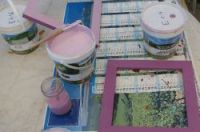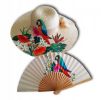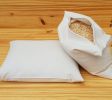Natural ecological paints

What are the paints we use for our hobbies, furniture and walls made of? What are the differences between "traditional" paints commonly found in supermarkets and natural paints?
To understand, you need to know that a paint is always made up of: - pigments: fine earth-based powders (ochres), metal oxides (oxides), calcinations (spinels) - binders to glue the pigment particles together - solvents, which evaporate when the paint dries - fillers: pigments with low covering power, which are economical and add other properties - additives.
In detail, depending on whether the paint is made from petroleum derivatives or natural materials, these elements are in reality quite different and rarely indicated on the pots, especially in hobby paints (there is a clear lack of legislation concerning the obligation to display the composition)
To understand, you need to know that a paint is always made up of: - pigments: fine earth-based powders (ochres), metal oxides (oxides), calcinations (spinels) - binders to glue the pigment particles together - solvents, which evaporate when the paint dries - fillers: pigments with low covering power, which are economical and add other properties - additives.
In detail, depending on whether the paint is made from petroleum derivatives or natural materials, these elements are in reality quite different and rarely indicated on the pots, especially in hobby paints (there is a clear lack of legislation concerning the obligation to display the composition)
Acrylic paints vs. natural paints
| Acrylic, glycerol and water-based paints | Natural paints | |
| Pigments | Petrochemical pigments (lead chromates, molybdenum reds, oxytitanium, zinc oxide, etc.) | Pigments include chalk, earth pigments, minerals and natural organic pigments from the animal or plant kingdom. |
| Binders | Synthetic resins: glycerophtalic resins ("glycero paint"), or alkyds (less harmful to the environment). | Natural oils, casein (milk protein), air lime (particularly environmentally-friendly), or potato starch. |
| Solvents | Hydrocarbons (petroleum distillates): Benzene, Xylene, Toluene or White Spirit, oxygenated chemical solvents (ketones, esters, alcohols), glycol ethers for "water-based" paints. | Real turpentine (from Portugal) or mineral spirits, citrus terpenes. |
| Disadvantages | VOCs are released over several months, polluting indoor air (health risk), are partly absorbed by household materials (released in hot weather) and contribute to ozone formation. Empty pots, rags and cleaning fluids must be taken to specialized centers. | Their smell, which can be strong, is that of the oils used. We recommend waiting at least a few days before bringing painted furniture into the house. |
The advantages of natural paints are, of course, that they emit no synthetic VOCs (neither during application, nor for months after drying...be careful, as some harmful VOCs are odorless...).
Brushes can be washed with soapy water; once dry, these paints are also washable. They are naturally micro-porous (allowing the wood to breathe).
Due to the presence of oil, these paints are reputed to take longer to dry. In our tests, whether for hobby paints, furniture paints or wall paints, this disadvantage was not observed.
Brushes can be washed with soapy water; once dry, these paints are also washable. They are naturally micro-porous (allowing the wood to breathe).
Due to the presence of oil, these paints are reputed to take longer to dry. In our tests, whether for hobby paints, furniture paints or wall paints, this disadvantage was not observed.
Natural painting in creative leisure

Paint on new or recycled wood, paint on textiles, the Natura paints we used gave us great satisfaction, with the only downside being the lasting odor of the colored paints.
It's very reassuring to use such paints for our little interior decorating projects. Unfortunately, sourcing them is more difficult: either over the Internet (but with rather dissuasive shipping costs), or locally in a few boutiques. The minimum packaging is 1 liter, which is a lot for hobby activities. We found the solution of buying the 5 basic colors and making the mixes to measure: a large part of the pleasure of painting is finding the right shade!
For the decoration of baby's room, on the other hand, as there were many elements to paint, the 3 colors used were chosen from a color chart.
Find out more...
- on the composition of paints on www.ecodis.info
- on natural paints



